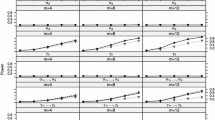Abstract
The PARELLA model is a probabilistic parallelogram model that can be used for the measurement of latent attitudes or latent preferences. The data analyzed are the dichotomous responses of persons to items, with a one (zero) indicating agreement (disagreement) with the content of the item. The model provides a unidimensional representation of persons and items. The response probabilities are a function of the distance between person and item: the smaller the distance, the larger the probability that a person will agree with the content of the item. This paper discusses how the approach to differential item functioning presented by Thissen, Steinberg, and Wainer can be implemented for the PARELLA model.
Similar content being viewed by others
References
Andersen, E. B. (1973). A goodness of fit test for the Rasch model.Psychometrika, 38, 123–140.
Bock, R. D., & Aitkin, M. (1981). Marginal maximum likelihood estimation of item parameters: application of an EM-algorithm.Psychometrika, 46, 443–459.
Bock, R. D., & Lieberman, M. (1970). Fitting a response model forn dichotomously scored items.Psychometrika, 35, 179–197.
Coombs, C. H. (1964).A theory of data. MI: Mathesis Press.
Dempster, A. P., Laird, N. M., & Rubin, D. B. (1977). Maximum likelihood from incomplete data via the EM-algorithm.Journal of the Royal Statistical Society, Series B, 39, 1–38.
Doosje, B. J., & Siero, F. W. (1991). Invloed van discrepantie tussen boodschap en eigen standpunt, kwaliteit van argumenten en motivatie tot elaboratie op de attitude ten aanzien vande auto-milieu-problematiek [Influence of discrepancy between message and attitude, influence of message quality on the attitude concerning the car-environment-issue]. In R. W. Meertens, A. P. Buunk, & R. van der Vlist.Sociale Psychologie (pp. 1–15), 's-Gravenhage: VUGA Uitgeverij B. V..
Fischer, G. H. (1974).Einfuhrung in die theorie psychologischer tests: grundlagen und anwendungen [Introduction to the theory of psychological tests: foundations and applications]. Bern: Huber.
Fischer, G. H. (1987). Applying the principles of specific objectivity and of generalizability to the measurement of change.Psychometrika, 52, 565–587.
Hoijtink, H. (1990). A latent trait model for dichotomous choice data.Psychometrika, 55, 641–656.
Hoijtink, H. (1991a). Measurement of latent traits by proximity items.Applied Psychological Measurement, 15, 153–170.
Hoijtink, H. (1991b).PARELLA, measurement of latent traits by proximity items. Leiden: DSWO-Press.
Hoijtink, H., Molenaar, I. W., & Post, W. J. (1992). PARELLA user's manual. Groningen, The Netherlands: iecProGAMMA.
Lord, F. M. (1980).Applications of item response theory to practical testing problems. Hillsdale, NJ: Lawrence Erlbaum.
Mood, A. M., Graybill, F. A., & Boes, D. C. (1985).Introduction to the theory of statistics. New York: McGraw-Hill.
Ramsay, J. O. (1975). Solving implicit equations in psychometric data analysis.Psychometrika, 40, 337–360.
Rost, J. (1990). Rasch models in latent classes: An integration of two approaches to item analysis.Applied Psychological Measurement, 14, 271–282.
Sachs, L. (1974).Angewandte Statistik [Applied statistics]. Berlin: Springer-Verlag.
Thissen, D., Steinberg, L., & Wainer, H. (1988). Use of item response theory in the study of group differences in trace lines. In H. Wainer & H. I. Braun (Eds.),Test validity (pp. 147–168). Hillsdale, NJ: Lawrence Erlbaum.
Author information
Authors and Affiliations
Additional information
Requests for the PARELLA software should be sent to Iec Progamma PO Box 841, 9700 AV Groningen, The Netherlands.
Rights and permissions
About this article
Cite this article
Hoijtink, H., Molenaar, I.W. Testing for DIF in a model with single peaked item characteristic curves: The parella model. Psychometrika 57, 383–397 (1992). https://doi.org/10.1007/BF02295426
Received:
Revised:
Issue Date:
DOI: https://doi.org/10.1007/BF02295426




